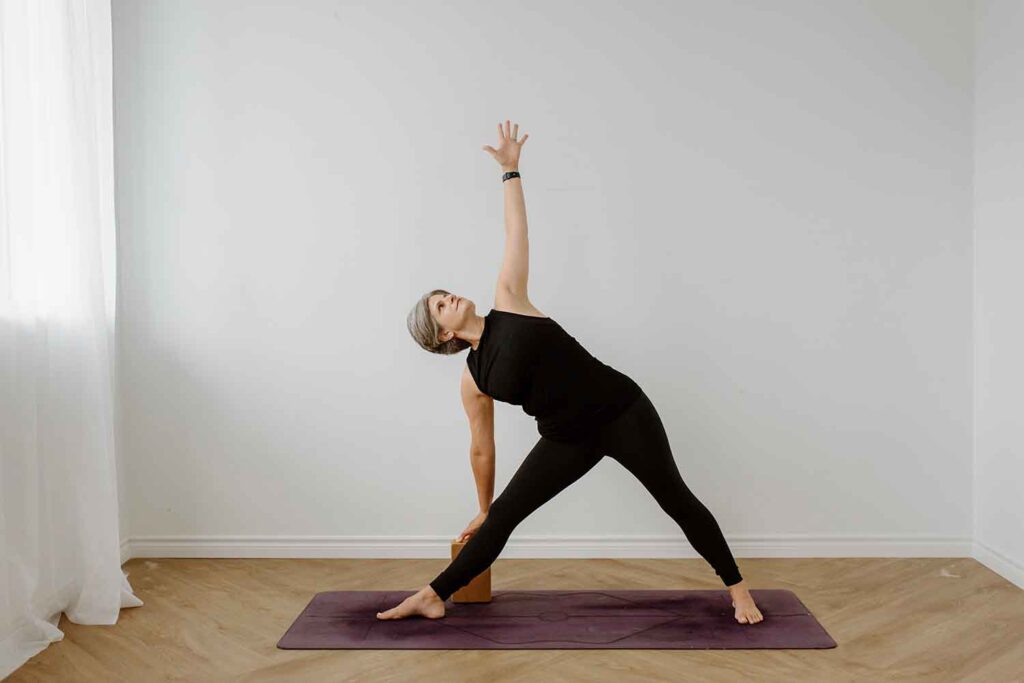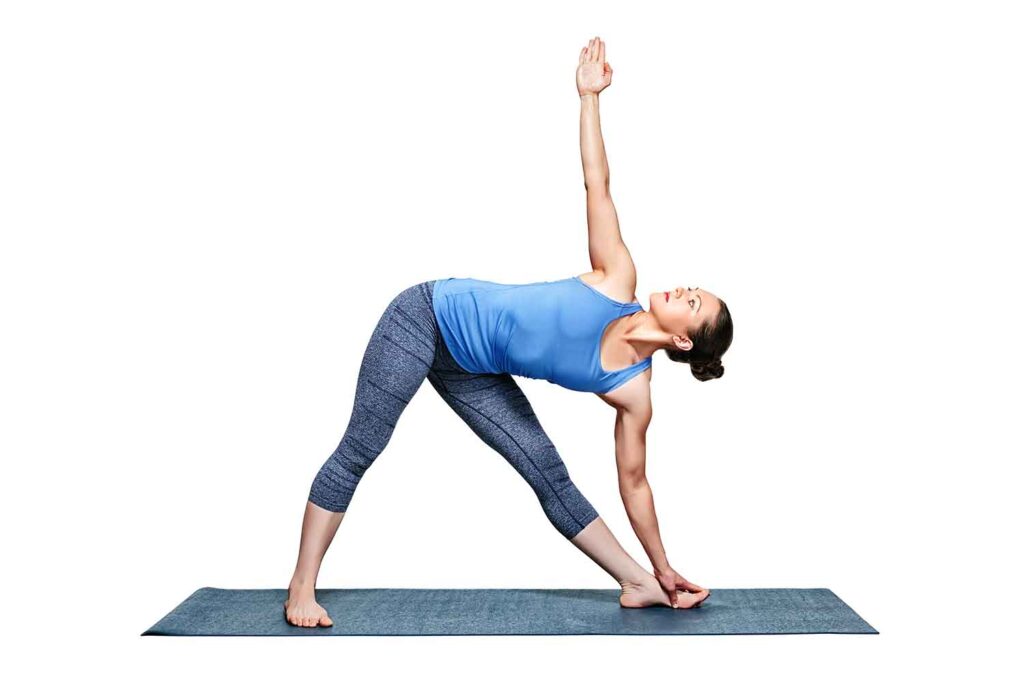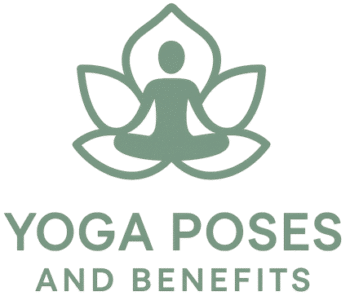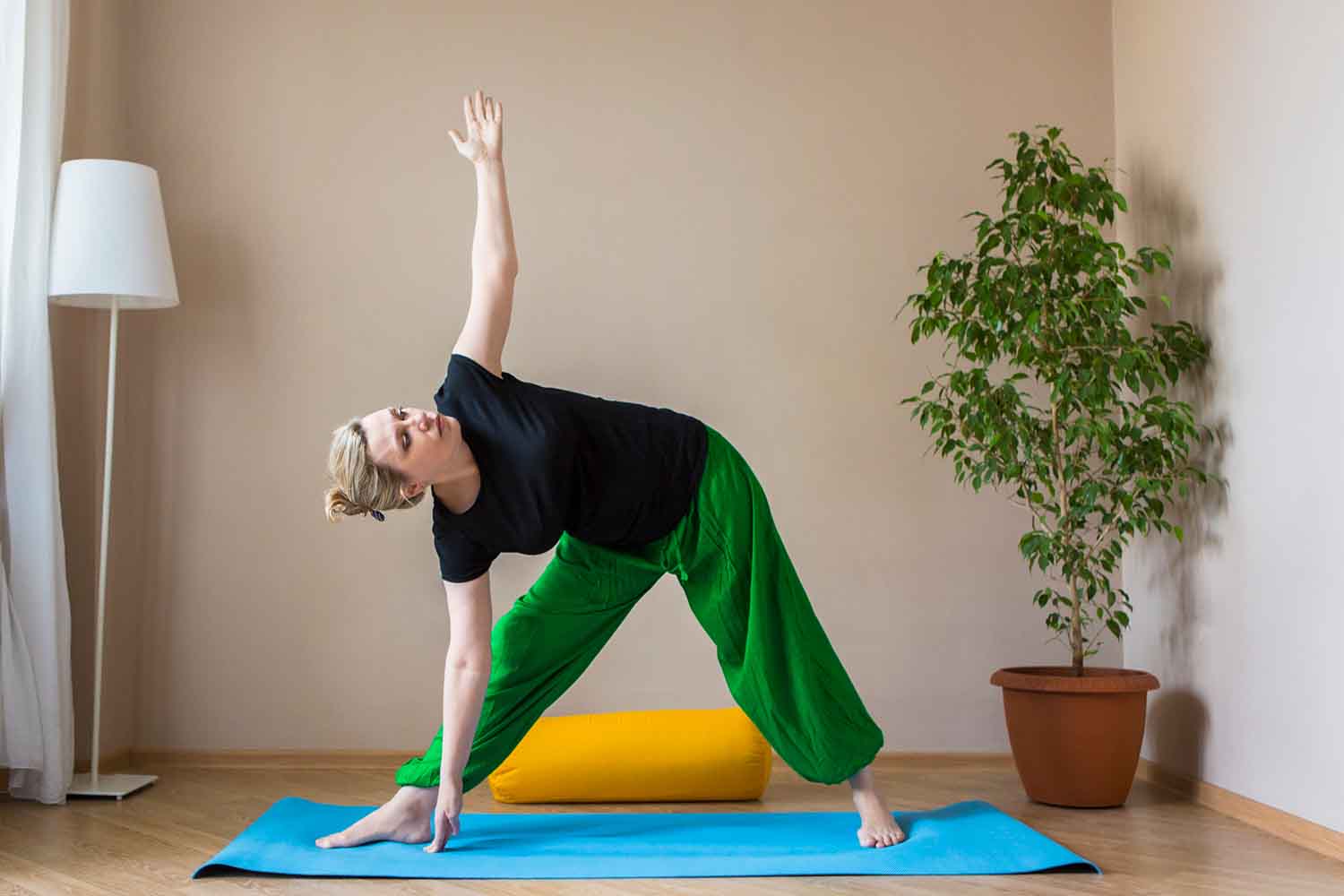Extended Triangle Pose in yoga (Utthita Trikonasana) is a foundational standing pose that offers a full-body stretch while promoting balance and stability. This posture strengthens the legs, opens the hips, and stretches the chest and shoulders. Practicing Extended Triangle helps improve posture, increases body awareness, and encourages deep, steady breathing, making it a vital pose in many yoga sequences.
Other Names for Extended Triangle Pose
Here are some of the common names for Extended Triangle Pose in yoga:
- Utthita Trikonasana (Extended Triangle Pose)
- Triangle Pose
- Trikonasana
How to Do Extended Triangle Pose in Yoga
To perform Extended Triangle Pose, follow these steps:
- Start by standing at the top of your mat in Mountain Pose. Step your feet wide apart, roughly 3-4 feet, and raise your arms parallel to the ground with palms facing down.
- Turn your right foot out 90 degrees and angle your left foot slightly inward. Align your right heel with the arch of your left foot.
- Inhale deeply and, as you exhale, reach your right hand forward, extending your torso over the right leg.
- Lower your right hand to your shin, ankle, or the floor (or use a block for support). Stretch your left arm toward the ceiling, keeping your arms in line with your shoulders.
- Open your chest toward the ceiling, engaging your core to avoid collapsing into the pose.
- Gaze up toward your left hand, keeping your neck relaxed. Hold for 5–10 breaths before switching sides.
Variations of Extended Triangle Pose
Exploring variations of Extended Triangle Pose can add depth to your practice:
- Bound Triangle Pose (Baddha Trikonasana): In this variation, you wrap your bottom arm behind your thigh and your top arm behind your back, clasping your hands. This deepens the chest and shoulder opening.
- Revolved Triangle Pose (Parivrtta Trikonasana): A twisted version of the pose where you rotate your torso toward the front leg, bringing the opposite hand to the outside of the front foot. This variation challenges balance and strengthens the core.
- Supported Triangle Pose: Place a block under your bottom hand to maintain alignment and prevent over-stretching, especially for beginners or those with limited flexibility.

Modifications for Extended Triangle Pose
If you find Extended Triangle Pose challenging, consider these modifications:
- Use a Block: Place a block under your hand to bring the ground closer. This allows you to maintain proper alignment and avoid overstretching.
- Bend the Front Knee: If you experience discomfort in your hamstrings, slightly bend your front knee to reduce the intensity of the stretch.
- Wall Support: Practice the pose with your back against a wall to encourage proper alignment of the shoulders, hips, and legs.
Contraindications for Extended Triangle Pose
Extended Triangle Pose offers many benefits but should be approached with caution in certain conditions:
- Neck or Shoulder Injuries: If you have any neck or shoulder discomfort, keep your gaze forward or down instead of looking up, and avoid overstretching your arms.
- Lower Back Pain: Focus on lengthening the spine rather than twisting too deeply, and consider placing your hand higher on your leg or using a block for support.
- High or Low Blood Pressure: Due to the slight inversion in this pose, those with blood pressure issues should avoid holding the position for extended periods or modify it to a gentler variation.
Tips to Improve Extended Triangle Pose in Your Practice
To refine your Extended Triangle Pose, focus on these key adjustments:
- Engage Your Legs: Press firmly through both feet, activating the legs to create a strong foundation and prevent collapsing into the pose.
- Lengthen the Torso: Instead of collapsing sideways, focus on creating length in both sides of the torso, keeping your spine long and neutral.
- Open the Chest: Rotate your chest upward, using your core to lift and create a deeper chest opening, while ensuring your shoulders stay stacked.
- Breathe Deeply: Inhale to lengthen, and exhale to deepen the stretch. Use your breath to maintain a steady rhythm and prevent strain.
- Use Props: A block or wall can assist in maintaining alignment while allowing you to build flexibility and strength over time.

What Muscles Does Extended Triangle Pose Work?
Extended Triangle Pose works various muscle groups throughout the body:
- Legs (Quadriceps and Hamstrings): The front leg stretches the hamstrings while the back leg remains active, engaging the quadriceps and stabilizing the pose.
- Core (Obliques and Abdominals): Your core muscles engage to support the torso, especially as you rotate and extend through the spine.
- Back (Erector Spinae): These muscles help maintain spinal alignment and contribute to the stretch along the length of the back.
- Chest and Shoulders: Extended Triangle opens the chest and shoulders, lengthening the pectoral muscles and improving posture.
- Hips and Groin: The pose stretches and opens the hips and groin area, increasing flexibility and mobility in the hip joints.
Mental and Emotional Benefits of Extended Triangle Pose
Extended Triangle Pose provides both physical and emotional benefits, enhancing mental well-being:
- Improves Focus and Concentration: By requiring balance and precise alignment, the pose encourages mental clarity and focus, drawing attention inward.
- Promotes Emotional Balance: The strong foundation and open chest in this pose encourage a feeling of stability and openness, promoting emotional grounding and release.
- Relieves Stress: Stretching the body and focusing on deep breathing helps reduce physical tension and relieve mental stress, creating a sense of calm.
- Boosts Energy: The pose stimulates circulation and energizes the body, making it an excellent way to increase vitality during your practice.
Is Extended Triangle Pose Suitable for Beginners?
Extended Triangle Pose is accessible for beginners with the right approach. For those new to yoga or with limited flexibility, using props like blocks can help maintain alignment without overstretching. Beginners should focus on the foundational elements of the pose, such as engaging the legs and keeping the torso long. Practicing with modifications and taking time to build flexibility in the hamstrings and hips will help ensure a safe and effective experience.
Is Extended Triangle Pose Suitable for Advanced Practitioners?
For advanced practitioners, Extended Triangle Pose provides opportunities to deepen the stretch and refine alignment. By holding the pose longer, they can focus on enhancing balance, increasing flexibility, and engaging the core more deeply. Advanced students may also explore variations such as Bound Triangle or Revolved Triangle to challenge their flexibility and strength, while fine-tuning the alignment of the hips and spine.
How Does Extended Triangle Pose Contribute to a Yoga Sequence or Flow?
Extended Triangle Pose serves as a key posture in many yoga sequences. It’s often used to transition between standing poses, offering both a stretch and a grounding point in a flow. The pose opens the hips, stretches the legs, and engages the core, making it an excellent preparatory posture for more challenging standing poses or twists. As a part of Sun Salutations or other flow sequences, Extended Triangle provides a moment to focus on alignment, breathing, and building strength through the legs and torso.
How Can I Deepen My Practice in Extended Triangle Pose?
To deepen your practice in Extended Triangle Pose, consider these steps:
- Engage the Core: Strengthen your abdominal muscles to support the rotation and prevent collapsing into the pose.
- Focus on Alignment: Pay attention to the alignment of your hips and shoulders. Ensure that your top shoulder stays stacked over the bottom, and your hips remain open.
- Use Props: Incorporate a block to lengthen the torso and support the stretch. Gradually lower the block as your flexibility improves.
- Extend Through the Arms: Actively reach through your fingertips in both directions to create space in the shoulders and upper body.
- Challenge Your Balance: Try practicing with your eyes closed to improve balance and body awareness, or transition into more advanced variations like Bound Triangle.
What Are Some Common Mistakes in Teaching Extended Triangle Pose?
Avoid these common mistakes when teaching Extended Triangle Pose:
- Collapsing the Torso: Students often collapse sideways rather than maintaining length in both sides of the torso. Encourage them to reach forward and extend the spine.
- Over-Rotating the Hips: Ensure the hips stay aligned and avoid excessive twisting in the front hip, which can lead to strain.
- Hyperextending the Front Knee: Remind students to keep a slight micro-bend in the front knee to protect the joint, especially if they are prone to hyperextension.
- Shoulders Misaligned: Students may let their top shoulder collapse forward. Instruct them to roll the shoulder back and open the chest toward the ceiling.
- Gaze Misalignment: Some practitioners strain their necks by forcing their gaze upward. Advise them to keep the neck relaxed and gaze where it feels most comfortable.
By addressing these common mistakes, teachers can help students maintain proper alignment, reduce strain, and experience the full benefits of Extended Triangle Pose.
What is the difference between Triangle Pose and extended triangle pose?
The difference between Triangle Pose and Extended Triangle Pose lies in the arm positioning. In Triangle Pose (Trikonasana), the top arm extends straight upward, while in Extended Triangle Pose (Utthita Trikonasana), the top arm may stretch overhead, creating a longer side body line. Both poses appear in Hatha Yoga and Vinyasa Yoga practices.
How to cue an extended triangle pose?
To cue an extended triangle pose, begin in Warrior II, straighten the front leg, and extend the front arm forward before lowering it to the shin or floor. Keep the chest open, shoulders stacked, and hips aligned. Engage the quadriceps and lengthen through both sides while grounding through the back foot.
When to avoid Trikonasana?
Avoid Trikonasana, or Extended Triangle Pose, if you have low blood pressure, a recent hip or spine injury, or chronic migraines. This yoga posture involves deep lateral stretching and torso rotation, which can strain the sacroiliac joint and lower back if not performed with proper alignment.
Which lifestyle disease does Trikonasana cure?
Trikonasana, also known as the extended triangle pose, helps manage lifestyle diseases such as diabetes, hypertension, and obesity. This yoga pose improves digestion, stimulates abdominal organs, and enhances flexibility, making it effective in supporting metabolic health and stress reduction, key factors in preventing chronic conditions.

